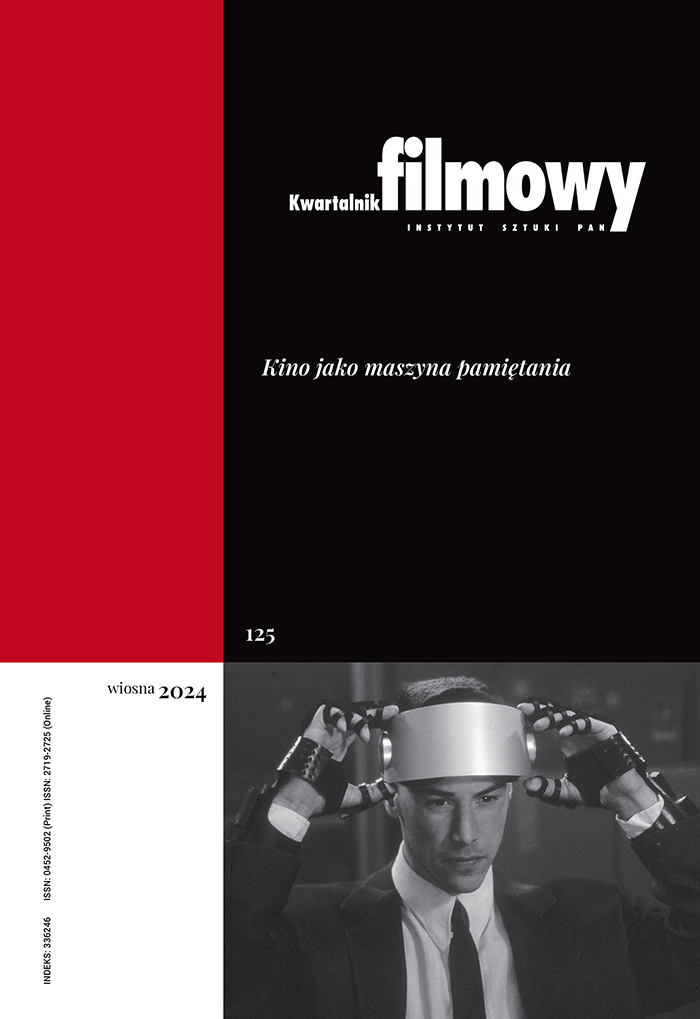From Narration to Monstration: Representing Trauma in Ivan Martinac’s “House on the Sand”
Višnja Pentić
visnja.pentic@gmail.comAcademy of Dramatic Arts University of Zagreb (Croatia)
https://orcid.org/0000-0001-9108-0429
Abstract
Ivan Martinac’s only feature film House on the Sand (Kuća na pijesku, 1985) is an avant-garde exploration of trauma within Yugoslav cinema, distinguished by its minimalist narrative and experimental techniques. Through parametric narration, the work deviates from traditional storytelling, embracing stylistic coherence over plot-driven narratives, akin to the approaches of directors like Robert Bresson and Michelangelo Antonioni. The narrative employs innovative cinematic techniques such as fixed camera positions, zooms, and pans. These elements emphasize the film’s internal coherence and detach the camera’s perspective from the characters, fostering an autonomous, meditative gaze. This approach aligns with André Gaudreault’s concept of monstration, wherein the camera itself actively constructs meaning through framing and movement, rather than merely documenting the plot. The camera serves as an omniscient yet alienated observer, reflecting Martinac’s broader philosophical engagement with the cinematic medium and its possibilities. This formal innovation situates the film as a unique artifact in both Croatian cinema and global filmmaking.
Keywords:
parametric narration, trauma representation, monstration, minimalism, slow cinema, camera gazeReferences
Agamben, G. (2000). Means Without End: Notes on Politics (trans. V. Binetti, C. Casarino). Minneapolis: University of Minnesota Press.
Google Scholar
Antonioni, M. (2007). Attempted Suicide: Suicides in the Cities (trans. A. Cooper). In: C. di Carlo, G. Tinazzi, M. Cottino-Jones (eds.), The Architecture of Vision: Writing and Interviews on Cinema (pp. 71-73). Chicago: The University of Chicago Press.
Google Scholar
Bordwell, D. (1985). Narration in the Fiction Film. Madison: University of Wisconsin Press.
Google Scholar
Branigan, E. (2006). Projecting a Camera: Language-Games in Film Theory. New York: Routledge.
Google Scholar
Braudy, L. (1984). The World in a Frame: What We See in Films. Chicago: Chicago University Press. (Original work published 1976).
Google Scholar
Burch, N. (1981). Theory of Film Practice (trans. H. R. Lane). Princeton: Princeton University Press. (Original work published 1969).
DOI: https://doi.org/10.1515/9781400853366
Google Scholar
Cavell, S. (1979). The World Viewed: Reflection on the Ontology of Film. Cambridge – London: Harvard University Press.
Google Scholar
Chatman, S. (1985). Antonioni, or, The Surface of the World. Berkeley: University of California Press.
DOI: https://doi.org/10.1525/9780520907669
Google Scholar
Chatman, S. (1990). Coming to Terms: The Rhetoric of Narrative in Fiction and Film. Ithaca – London: Cornell University Press.
Google Scholar
Chion, M. (1999). The Voice in Cinema (trans. C. Gorbman). New York: Columbia University Press. (Original work published 1982).
Google Scholar
Féral, J. (1996). “Performance” i teatralnost: demistificirani subjekt (trans. T. Brlek). Zor: časopis za književnost i kulturu, 1 (1), pp. 207-216.
Google Scholar
Gaudreault, A. (2009). From Plato to Lumière: Narration and Monstration in Literature and Cinema (trans. T. Barnard). Toronto: University of Toronto Press. (Original work published 1988).
DOI: https://doi.org/10.3138/9781442688148
Google Scholar
Kawin, B. (1978). Mindscreen: Bergman, Godard and First-Person Film. Princeton: Princeton University Press.
Google Scholar
Kovács, A. B. (2007). Screening Modernism: European Art Cinema, 1950-1980. Chicago: The University of Chicago Press.
DOI: https://doi.org/10.7208/chicago/9780226451664.001.0001
Google Scholar
Laffay, A. (1971). Logika filma: stvaranje i predstava (trans. A. Frangeš). Beograd: Institut za film. (Original work published 1964).
Google Scholar
Martinac, I. (1968). Iskaz, no 3. Sineast, 1 (5), pp. 59-62.
Google Scholar
Martinac, I. (1986). “Kuća na piesku” – bilješke autora. In: Alternative film-video 1986 (festival catalogue, pp. 75-86). Belgrade: Akademski filmski centar.
Google Scholar
Martinac, I. (1992). Ulazak u Jeruzalem. Split: Narodno sveučilište Split.
Google Scholar
Martinac, I. (2001). Martinac: 41 godina filmskog stvaralaštva, 1960-2001. Split: Otvoreno pučko učilište Split.
Google Scholar
Pavičić, J. (2010). Kuća na pijesku. In: Subversive Film Festival: socijalizam: 1-25.05.2010 (festival catalogue, p. 75). Zagreb: Udruga Bijeli val.
Google Scholar
Perez, G. (1998). The Material Ghost: Films and Their Medium. Baltimore: The John Hopkins University Press.
Google Scholar
Šakić, T. (2016). Modernizam u hrvatskom igranom filmu: nacrt tipologije. Zagreb: Disput.
Google Scholar
Vrvilo, T. (2007). Filmovi Ivana Martinca: taktilnost u zaljepcima. Hrvatski filmski ljetopis, 13 (52), pp. 44-54.
Google Scholar
Authors
Višnja Pentićvisnja.pentic@gmail.com
Academy of Dramatic Arts University of Zagreb Croatia
https://orcid.org/0000-0001-9108-0429
A graduate of Comparative Literature and English Language and Literature from the Faculty of Humanities and Social Sciences, University of Zagreb, where she also earned a PhD in Film Studies. She teaches film theory at both the Academy of Dramatic Arts and the Faculty of Humanities and Social Sciences. In 2012, she received the Vladimir Vuković Award for Best New Critic and in 2016, the annual Vladimir Vuković Award for Best Critic. She contributes essays on literature, cinema, and visual arts to Croatian Radio Channel 3 and various magazines. She is the author of the book Prozori – ogledi iz filmske stvarnosti (2023) with essays on 72 Croatian short films from the second half of the 20th century. In 2020, she launched an annual programme of free public lectures on cinema at the Cinema Club Zagreb.
Statistics
Abstract views: 181PDF downloads: 83
License
Copyright (c) 2025 Višnja Pentić

This work is licensed under a Creative Commons Attribution 4.0 International License.
The author grants the publisher a royalty-free non-exclusive licence (CC BY 4.0) to use the article in Kwartalnik Filmowy, retains full copyright, and agrees to identify the work as first having been published in Kwartalnik Filmowy should it be published or used again (download licence agreement). The journal is published under the CC BY 4.0 licence. By submitting an article, the author agrees to make it available under this licence.
In issues from 105-106 (2019) to 119 (2022) all articles were published under the CC BY-NC-ND 4.0 licence. During this period the authors granted a royalty-free non-exclusive licence (CC BY-ND 4.0) to use their article in „Kwartalnik Filmowy”, retained full copyright, and agreed to identify the work as first having been published in our journal should it be published or used again.











